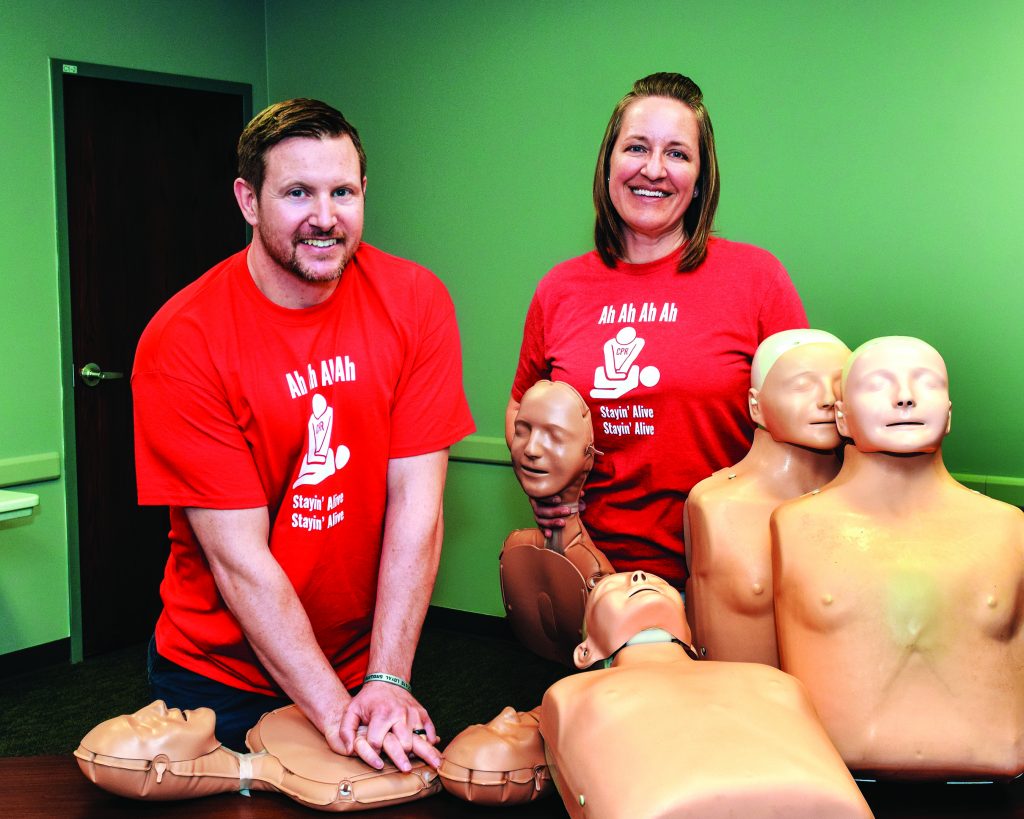
Kristi Engelstad, outreach coordinator of F-M Ambulance Service (right), and Skyler Dutton are on a mission to teach the community the life-saving technique of hands-only CPR, an easily learned way to sustain someone who has stopped breathing for the 10 minutes or so it takes for professional first responders to arrive. (Photo/Russ Hanson)
Nancy Edmonds Hanson
hansonnanc@gmail.com
If someone falls and stops breathing – a loved one, a stranger on the street – you can be a hero. Your quick action can keep them alive until the first responders arrive, lights flashing. All it takes is your two hands, a sense of rhythm … and the courage to step up to save a life.
That’s the message that F-M Ambulance Service’s Kristi Engelstad has been spreading far and wide. For the past three months, the experienced paramedic has been carrying the gospel of hands-only CPR to, she says, any group that will sit still and listen. Powered by a grant from the American Heart Association, she’s been recruiting volunteers who promise in turn to teach the easy-to-learn technique to at least five more people.
In exchange for their pledge, she provides them with a kit including an educational DVD and a small inflatable practice dummy. She and former police officer Skyler Dutton, who joined her last month, are now at the tail end of distributing the last of the 600 kits funded by the grant, but she says the campaign will still go on.
The need is dramatic. “Here in Fargo-Moorhead, 34 percent of those who suffer cardiac arrest or a heart attack in a non-hospital setting get the immediate assistance that could keep them alive until the paramedics arrive,” she says. “That compares with 48 percent nationwide. We should – we can – do better.”
Most people are generally familiar with the standard approach to cardiopulmonary resuscitation or CPR. The recommendation: 30 chest compressions per minute plus two mouth-to-mouth rescue breaths. “It hasn’t gone away. That’s still what emergency responders are taught.
But, says Kristi, the mouth-to-mouth part may be discouraging civilians from giving aid when it’s needed, especially to strangers. “We realized people weren’t doing it because, basically, it’s gross,” she says. “So we’ve made it simple and easy.
“When someone collapses from cardiac arrest or another cause and stops breathing, they still have enough oxygenated blood to keep going for about 10 minutes – long enough for a 911 call to bring the paramedics. If you can keep the heart circulating that blood through the body until they get there, the victim’s chances of survival are much, much better.”
Kristi knows firsthand that knowledge can save a life. On the Sunday after Thanksgiving, her 35-year-old cousin Kadie Stoltz was home alone with her 4-year-old twins and 8-year-old daughter when she suffered cardiac arrest. The little girl ran barefoot through the snow to summon help next door. The neighbor performed CPR until first responders arrived, and Kadie lived to tell the story … which she has, at Kristi’s side, at several local events this winter. According to statistics, only one in 10 victims of cardiac arrest survives.
Skyler describes the technique: First, call 911! Then kneel beside the victim and place the heel of one hand over the center of his chest. Cover that with your other hand, positioning your shoulders over your wrists. Then bear down as hard and fast as you can. The goal is 100 chest compressions per minute … in time to the beat of “Stayin’ Alive” or, for the younger set, “Baby Shark.” Both tunes have just the right tempo. “So does ‘Another One Bites the Dust,’” he offers with a grin. “But under the circumstances, you wouldn’t want anyone to hear you humming that one.
“Don’t be afraid you’re going to hurt the victim,” he adds. “Give it all the weight of your torso. You’re going to get tired. Look around for someone else who can jump in when you need help.”
If someone else is nearby, they should search out an AED device, an “automated external defibrillator.” They’re on hand in many public buildings, shopping centers and the like. If the victim has no heartbeat, they can be used to shock the heart back in rhythm. “Just follow the instructions exactly as shown,” Skyler advises. “Trust me – you’ll be able to figure it out.” But while you’re looking for an AED, keep pumping.
The Heart Association has been working for years to educate the public in how to step in when an emergency occurs. “If someone is unresponsive and not breathing, that could be cardiac arrest, a heart attack, a stroke, aneurysm,” Skyler explains. “It’s more common than you might think.”
In 10 years as a police officer, he only encountered these situations a few times. Kristi says, though, that they’re one of the most common ambulance calls: “Our first responders stay busy with these calls every single day. If someone’s there to keep the blood flowing during the first few critical moments ’til they can get there, it makes all the difference in the world.”
To arrange a lesson in hands-only CPR for your group, contact Kristi by calling (701) 364-1759 or emailing kristi.englstad@fmambulance.com


